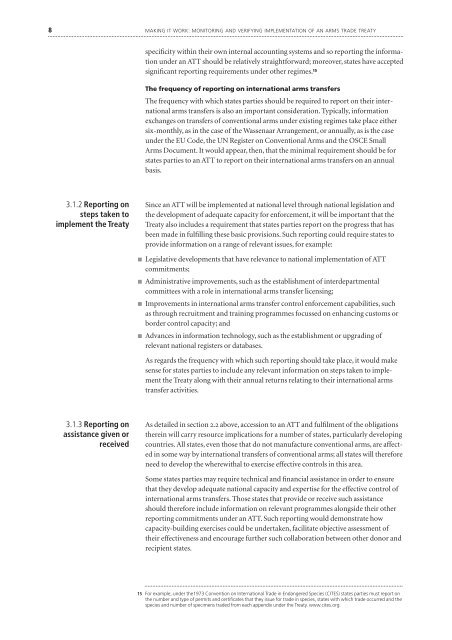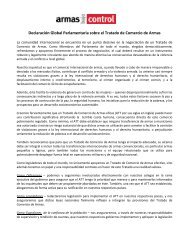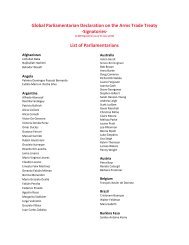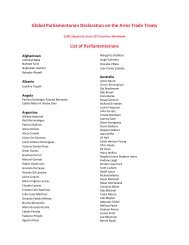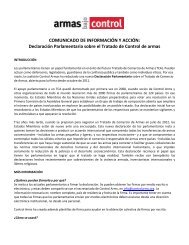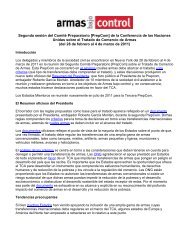SAFERWORLD 7Ultimately, however, <strong>it</strong> should be the scope of an ATT that defines the extent of thereporting requirements. NGO commentators 11 and a significant number of governments12 have argued that an ATT should be comprehensive in scope, addressing theimport, export, trans<strong>it</strong>, transhipment and brokerage of all conventional weaponswhether the transfers are state-to-state, state-to-private end-user, commercial sales,leases; and loans or gifts or any other form of international transfer of material goodsor cred<strong>it</strong> or expertise. Thus, requirements for reporting on international armstransfers under an ATT should reflect the full extent of the international arms transfercontrol comm<strong>it</strong>ments enshrined w<strong>it</strong>hin the Treaty.At the same time there are strong arguments in favour of reporting on internationalarms transfers to all states – as opposed only to states parties or non-parties. It iscrucial that an ATT is conceived and developed as a non-discriminatory regime in thatthe controls enshrined in the Treaty are applied consistently towards all; this should bedemonstrated through the requirement that reporting by states parties on their internationalarms transfers should include all recipients. Secondly, as mentioned above, <strong>it</strong>will be important for the effective functioning of the regime that all parties candemonstrate that they are implementing ATT provisions in good fa<strong>it</strong>h and the bestway to achieve this is by reporting on all international arms transfers.The level of detail in reporting on international arms transfersAnother question relates to the extent or level of detail that should be provided inexchanges of information on international arms transfers. A review of existing multilateralarms transfer control fora again illustrates a variety of practices. Under the EUCode of Conduct information is provided according to agreed EU Common Mil<strong>it</strong>aryList categories while exchanges of information on international SALW transfers byOSCE states include Mil<strong>it</strong>ary List category and sub-category. Under the WassenaarArrangement and the UN Register on Conventional <strong>Arms</strong> Transfers, information isprovided on eight specified categories of conventional arms (seven categories of majorconventional weaponry plus small arms and light weapons – see Annex 1).In order for an ATT to function effectively, sufficient information will be required(on international arms transfers falling w<strong>it</strong>hin the scope of the Treaty) so as to allowaccurate assessment of such transfers against the specified obligations. It is unlikelythat providing information under eight broad categories covering complete weaponssystems (as per the UN Register and the Wassenaar Arrangement) will be sufficient toallow effective assessment of all international arms transfers against the comm<strong>it</strong>mentsset out in an ATT. Indeed, under this system, transfers of many important weaponsand related components and sub-systems that do not fall w<strong>it</strong>hin these establishedcategories would go unreported. While reporting on international arms transfersaccording to existing Mil<strong>it</strong>ary List categories (as used, for example, by EU states)would be preferable, some Mil<strong>it</strong>ary List categories are extremely broad, for example,covering everything from combat helicopters to parachutes, 13 and provision of informationat this level would not perm<strong>it</strong> accurate assessments to be made. The provisionof further detail, such as through disclosure of Mil<strong>it</strong>ary List sub-categories, could be ofgreater util<strong>it</strong>y in allowing objective scrutiny of international arms transfers. 14 Clearlythe greater the level of reporting detail required then the more effective an ATT wouldbe, however the arch<strong>it</strong>ects of an ATT will need to balance this against the administrativeworkload thus created. Nonetheless, <strong>it</strong> should be remembered that states willtypically be recording the details of international arms transfers to at least this level of11 Assessing the Feasibil<strong>it</strong>y, Scope and Draft Parameters of an <strong>Arms</strong> Trade Treaty: An NGO Perspective, the <strong>Arms</strong> Trade TreatySteering Comm<strong>it</strong>tee, February 2007. http://web.amnesty.org/library/Index/ENGACT300022007?open&of=ENG-39012 The Global <strong>Arms</strong> Trade Treaty: What States Want pp 16–18 and Analysis of States’ Views on an <strong>Arms</strong> Trade Treaty p 7.13 See EU Common Mil<strong>it</strong>ary List Category ML10 “‘Aircraft’, ‘lighter-than-air vehicles’, unmanned airborne vehicles, aeroenginesand ‘aircraft’ equipment, related equipment and components, specially designed or modified for mil<strong>it</strong>ary use.”http://eur-lex.europa.eu/LexUriServ/s<strong>it</strong>e/en/oj/2007/l_088/l_08820070329en00580089.pdf14 Under the EU Common Mil<strong>it</strong>ary List the Category ML10 has nine sub-categories (listed a to i) some of which have furthersub-divisions. For example ML10 h: “Parachutes and related equipment, used for combat personnel, cargo dropping or‘aircraft ‘deceleration, as follows, and specially designed components therefor:” has eight further sub-categories ofparachute, some of which are sub-divided further.
8 MAKING IT WORK: MONITORING AND VERIFYING IMPLEMENTATION OF AN ARMS TRADE TREATYspecific<strong>it</strong>y w<strong>it</strong>hin their own internal accounting systems and so reporting the informationunder an ATT should be relatively straightforward; moreover, states have acceptedsignificant reporting requirements under other regimes. 15The frequency of reporting on international arms transfersThe frequency w<strong>it</strong>h which states parties should be required to report on their internationalarms transfers is also an important consideration. Typically, informationexchanges on transfers of conventional arms under existing regimes take place e<strong>it</strong>hersix-monthly, as in the case of the Wassenaar Arrangement, or annually, as is the caseunder the EU Code, the UN Register on Conventional <strong>Arms</strong> and the OSCE Small<strong>Arms</strong> Document. It would appear, then, that the minimal requirement should be forstates parties to an ATT to report on their international arms transfers on an annualbasis.3.1.2 Reporting onsteps taken toimplement the TreatySince an ATT will be implemented at national level through national legislation andthe development of adequate capac<strong>it</strong>y for enforcement, <strong>it</strong> will be important that theTreaty also includes a requirement that states parties report on the progress that hasbeen made in fulfilling these basic provisions. Such reporting could require states toprovide information on a range of relevant issues, for example:■ Legislative developments that have relevance to national implementation of ATTcomm<strong>it</strong>ments;■ Administrative improvements, such as the establishment of interdepartmentalcomm<strong>it</strong>tees w<strong>it</strong>h a role in international arms transfer licensing;■ Improvements in international arms transfer control enforcement capabil<strong>it</strong>ies, suchas through recru<strong>it</strong>ment and training programmes focussed on enhancing customs orborder control capac<strong>it</strong>y; and■ Advances in information technology, such as the establishment or upgrading ofrelevant national registers or databases.As regards the frequency w<strong>it</strong>h which such reporting should take place, <strong>it</strong> would makesense for states parties to include any relevant information on steps taken to implementthe Treaty along w<strong>it</strong>h their annual returns relating to their international armstransfer activ<strong>it</strong>ies.3.1.3 Reporting onassistance given orreceivedAs detailed in section 2.2 above, accession to an ATT and fulfilment of the obligationstherein will carry resource implications for a number of states, particularly developingcountries. All states, even those that do not manufacture conventional arms, are affectedin some way by international transfers of conventional arms; all states will thereforeneed to develop the wherew<strong>it</strong>hal to exercise effective controls in this area.Some states parties may require technical and financial assistance in order to ensurethat they develop adequate national capac<strong>it</strong>y and expertise for the effective control ofinternational arms transfers. Those states that provide or receive such assistanceshould therefore include information on relevant programmes alongside their otherreporting comm<strong>it</strong>ments under an ATT. Such reporting would demonstrate howcapac<strong>it</strong>y-building exercises could be undertaken, facil<strong>it</strong>ate objective assessment oftheir effectiveness and encourage further such collaboration between other donor andrecipient states.15 For example, under the1973 Convention on International Trade in Endangered Species (CITES) states parties must report onthe number and type of perm<strong>it</strong>s and certificates that they issue for trade in species, states w<strong>it</strong>h which trade occurred and thespecies and number of specimens traded from each appendix under the Treaty. www.c<strong>it</strong>es.org.


